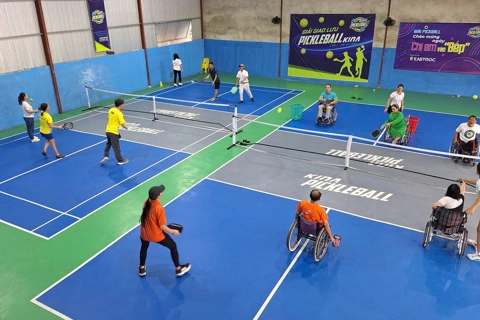More public spaces needed in Hanoi to improve living standards
Public spaces in Hanoi are still far from meeting the world standard of 9 square meters per person.
Hanoi has been experiencing rapid urbanization for the past years with a lot of large-scale infrastructure works erected in the city. However, very few of them are public squares and parks, making a city’s public space planning imperative, Kinh Te & Do Thi quoted experts as saying.
Public spaces play an important role in improving urban residents’ life quality. However, Hanoi lacks spaces for planting trees and digging lakes. On average, each Hanoi citizen has only 3 square meters of public space, according to architect Dinh Dang Hai, an expert of HealthBridge Canada in Vietnam.
| Paster flower garden in Hai Ba Trung district. Photo: Thuy Anh |
Thus, the average public space in Hanoi is still far from meeting the world standard of 9 square meters per person.
"Studies have shown that the shortage of public spaces in urban areas can increase obesity and traffic accidents," said the architect.
According to Hanoi’s general planning in 2011, the city’s green space would reach 9m2 per person.
Relocation of factories out of downtown
Most urban environmental experts believe that there are too many industrial factories in Hanoi’s densely-populated areas, putting pressure on the living environment.
Therefore, relocating factories out of Hanoi's residential areas is an urgent solution, especially given the incidents which have happened over the past one year, for instance, the fires at a bulb factory of Rang Dong Light Source and Vacuum Flask Joint Stock Company and a chemical factory in Duc Giang, Long Bien district.
According to a survey by the Working Group for People Participation (PPWG) in May and June 2020 with 512 people living in Hanoi, nearly 60% said that their living spaces were being affected by the factories’ operation, in which the level of toxic air pollution accounts for 80.52%. Especially, 98.49% of the respondents supported the decision to relocate polluting factories out of Hanoi’s downtown.
The Vietnamese government has adopted a policy of relocating contaminating industrial plants out of the central area and using post-relocation space for green spaces.
Architect Dinh Dang Hai said, not only in Hanoi, many big cities in the world have developed public spaces in the premises of production facilities after they are moved out of the inner city.
The problem here is the need to plan and the serious determination to implement it, taking into account the factor of green space. In particular, the government needs to mobilize the participation of the community in contributing ideas, as well as monitoring the implementation of the plans to make Hanoi a livable city.











